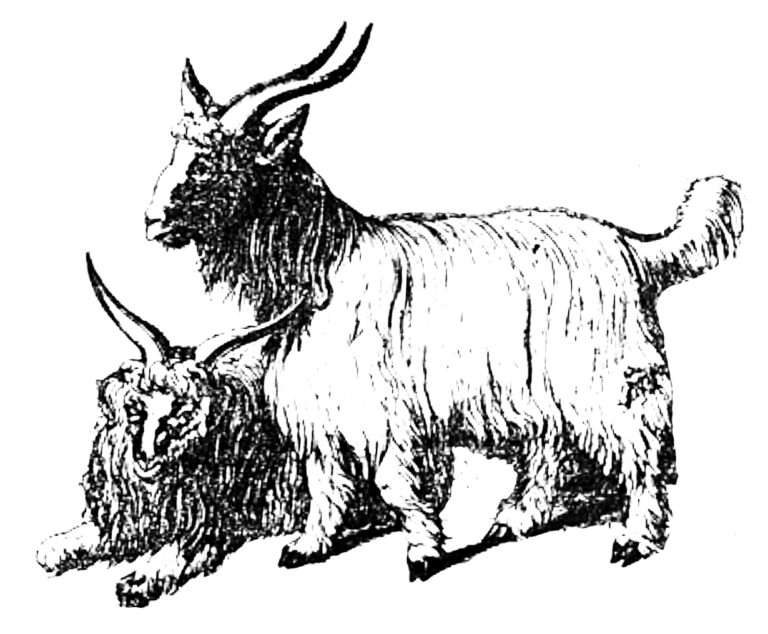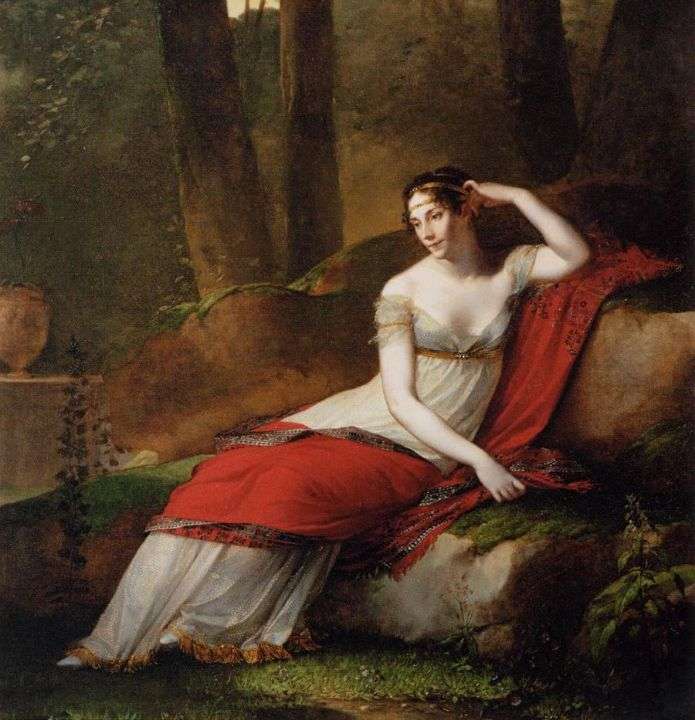Pashmina (/pʌʃˈmiːnə, pæʃ-/, also US: /pɑːʃ-/) is a term that, depending on the source, can refer to cashmere wool from the Changthangi cashmere goat, fine Indian cashmere wool, or a synonym for cashmere wool in general. The word “pashm” means “wool” in Persian, but in Kashmir, it specifically referred to the raw, unspun wool of domesticated Changthangi goats. Today, the term “pashmina” can refer either to the material itself or to the variant of the Kashmir shawl that is made from it. Both cashmere and pashmina come from the same goat, but typical cashmere ranges from 12 to 21 microns in diameter, while pashmina can also refer to a cashmere and silk blend (70% / 30%) that has a typical fiber range of 12 to 16 microns.
Wool fibres found from corroded copper artifacts from Harappa dating back to the Indus Valley civilization resemble Pashmina and Shatoosh. Pashmina gained prominence through its use in the Kashmir shawl. In Mughal times, Pashmina was used as an indicator of rank and nobility. In 1526, Babur founded the Mughal Empire in India and established the practice of giving khilat (or “robes of honor,” typically made of expensive fabric) to members of their durbar to indicate high service, great achievement, or royal favor. The Mughal khilat was a set of clothes that could include a turban, long coat, gown, fitted jacket, sash, shawl, trousers, shirt, and scarf. One or all of these could be made of Pashmina and embroidered in gold cloth.
In 1568, Kashmir was conquered by Babur’s grandson Akbar. In Akbar’s time, a pair of Pashmina shawls was an expected part of khil’at ceremonies. From the 16th to the early 20th centuries, the Safavid, Zand, and Qajar emperors of Iran also wore Pashmina and gifted Kashmir shawls as khilat within their political and religious practices. Pashmina blankets were also vital additions to a wealthy woman’s dowry in India, Pakistan, and Nepal. In nineteenth-century English writing, despite the fact that shawls were worn by men, Kashmiri shawls became coded as women’s luxuries. They acquired the status of heirlooms, worn by a girl on her marriage and coming-of-age and as heirlooms that women would inherit rather than purchase.
In France, the Pashmina Kashmir shawl gained status as a fashion icon through Empress Joséphine’s enthusiastic use. These shawls suited the French well, providing the needed warmth while adding visual interest to white French gowns through the traditional teardrop buta pattern and discreet floral motifs. The shawl became a symbol of French bourgeois status from the Bourbon Restoration (1815–48) through the Second French Empire (1852–70). As a class marker, it fulfilled 19th-century French tastes because it looked rich, had extensive ornamentation, artistic qualities, and was made of expensive raw materials.
パシュミナ(/pʌʃˈmiːnə, pæʃ-/, also US: /pɑːʃ-/)はチャンタンギ山羊のカシミヤ毛、インドの高級カシミヤ毛、またはカシミヤ毛一般の同義語を指すことがある言葉である。パシュムはペルシャ語で「羊毛」を意味しますが、カシミール地方では特に家畜化されたチャンタンギヤギの紡がれていない原毛を指していました。現在では、パシュミナは素材そのものを指す場合と、それを使ったカシミール・ショールの一種を指す場合があります。カシミヤとパシュミナは同じ山羊から採れるが、カシミヤは直径12〜21ミクロン、パシュミナはカシミヤとシルクのブレンド(70%/30%)で、直径12〜16ミクロンの繊維を指すこともある。
インダスバレー文明のハラッパから出土した腐食銅器から発見されたウールの繊維は、パシュミナやシャトーシュに類似しています。パシュミナはカシミール地方のショールに使用され、注目を浴びました。ムガール帝国時代には、パシュミナは階級や高貴さを表すものとして使われていました。1526年、インドにムガール帝国を建国したバブールは、高い奉仕や功績、王室の好意を示すために、ダーバルのメンバーにキラット(高価な生地で作られた「名誉の衣」)を与える習慣を確立しました。ムガール人のキラットは、ターバン、ロングコート、ガウン、フィットしたジャケット、サッシ、ショール、ズボン、シャツ、およびスカーフを含むことができる服のセットであった。これらのうち1つ、またはすべてがパシュミナで作られ、金の布で刺繍されていることもあった。
1568年、カシミール地方はバーブルの孫にあたるアクバルに征服された。アクバルの時代には、パシュミナのショールはキルアトのセレモニーに欠かせないものとなっていました。16世紀から20世紀初頭にかけて、イランのサファヴィー朝、ザンド朝、カージャール朝の皇帝たちも、政治的、宗教的な慣習の中で、パシュミナのショールや贈られたカシミールのショールをキルアットとして身に着けていました。また、インド、パキスタン、ネパールでは、パシュミナの毛布は裕福な女性の持参金として欠かせないものでした。19世紀の英国の書物では、ショールは男性が身につけるものであるにもかかわらず、カシミール・ショールは女性の贅沢品として扱われるようになった。少女が結婚や成人の際に身につけ、女性が購入するよりも受け継ぐ家宝のような地位を獲得した。
フランスでは、パシュミナのカシミールショールが皇后ジョゼフィーヌの愛用によってファッションアイコンとしての地位を確立した。このショールはフランス人によく似合い、必要な暖かさを提供すると同時に、伝統的なティアドロップ・ブタ模様や控えめな花のモチーフによって、白いフレンチドレスに視覚的な面白さを添えている。ショールはブルボン王政復古期(1815-48)から第二帝政期(1852-70)にかけて、フランスのブルジョワ階級の象徴となった。見た目が豊かで、装飾が多く、芸術性が高く、高価な素材で作られているため、階級を示すものとして、19世紀フランスの嗜好を満たしていたのである。
Pashmina refers to a fine type of cashmere wool that is obtained from the undercoat of a particular breed of goat called the Changthangi goat, which is native to the high-altitude regions of the Himalayas in India, Nepal, and Pakistan.The history of pashmina can be traced back to the Indus Valley Civilization in the Indian subcontinent, where samples of wool fibers similar to pashmina were discovered from corroded copper artifacts dating back to that period. However, it gained prominence during the Mughal Empire in India, particularly during the reign of Babur, who established the practice of giving khilat or robes of honor made of expensive fabric to members of his durbar to indicate high service, great achievement, or royal favor.
In the 16th century, the Mughal Emperor Akbar conquered Kashmir, and pashmina shawls became an expected part of khil’at ceremonies. From the 16th to the early 20th centuries, the Safavid, Zand, and Qajar emperors of Iran also wore pashmina and gifted Kashmir shawls as khilat within their political and religious practices.Pashmina blankets were also a vital addition to a wealthy woman’s dowry in India, Pakistan, and Nepal. In the 19th century, Kashmiri shawls became coded as women’s luxuries, and they acquired the status of heirlooms, worn by a girl on her marriage and coming-of-age, and as heirlooms that women would inherit rather than purchase.
Attributed to Abid, Jahangir Receives Prince Khurram, Ajmer, April 1616, from the Windsor Padshahnama, India, Mughal dynasty, ca. 1635–36. / Khilat (also spelled as khil’at or khilafat) refers to a type of traditional robe of honor or dress that was typically made of expensive fabric and bestowed as a gift by Mughal emperors in India to reward or honor their subjects for their services or achievements. The term “khilat” literally means “clothing” or “raiment” in Arabic.
In France, pashmina Kashmir shawls gained status as a fashion icon through Empress Joséphine’s enthusiastic use. These shawls suited the French well, providing the needed warmth, while adding visual interest to white French gowns through the traditional teardrop buta pattern and discreet floral motifs. The shawl became a symbol of French bourgeois status from the Bourbon Restoration (1815–48) through the Second French Empire (1852–70).
パシュミナは、インド、ネパール、パキスタンのヒマラヤ山脈の高地に生息するチャンタンギ山羊という品種の山羊の下毛から取れる上質なカシミヤウールのことを指します。 パシュミナの歴史は、インド亜大陸のインダスバレー文明にまで遡り、その時代の腐食銅器からパシュミナに似た毛繊維のサンプルが発見されたことから始まります。しかし、インドのムガル帝国、特にバーブルの時代になると、バーブルは、高い功績や業績、王室の好意を示すために、高価な生地でできたキラット(名誉の衣)を幕僚に与える習慣を確立し、注目を浴びるようになった。16世紀にはムガル帝国皇帝アクバルがカシミールを征服し、パシュミナ・ショールがキルアトの儀式に用いられるようになった。16世紀から20世紀初頭にかけて、イランのサファヴィー朝、ザンド朝、カージャール朝の皇帝もパシュミナを着用し、カシミール・ショールをキルアトとして政治的・宗教的な慣習の中で贈りました。 また、インド、パキスタン、ネパールでは、パシュミナの毛布は裕福な女性の持参金として欠かせないものでした。19世紀には、カシミール・ショールは女性の贅沢品としてコード化され、少女が結婚や成人の際に身につける家宝としての地位を獲得し、女性が購入するよりも受け継ぐべきものとして定着しました。フランスでは、パシュミナのカシミールショールが皇后ジョゼフィーヌの愛用によりファッションアイコンとしての地位を確立した。このショールはフランス人によく似合い、必要な暖かさを提供するとともに、伝統的な涙のブタ模様や控えめな花のモチーフによって、フランスの白いガウンに視覚的な面白さを添えている。ショールはブルボン王朝の時代(1815-48)から第二帝政期(1852-70)まで、フランスのブルジョワ階級の象徴とされた。
Pashmina shawls gained popularity in France during the 18th and 19th centuries when they were imported from India and Kashmir. French Empress Josephine Bonaparte, the wife of Napoleon Bonaparte, was particularly fond of these shawls and was known to wear them frequently. She even started a trend among French women of wearing shawls draped over their shoulders and arms.
L’impératrice Joséphine, par Pierre-Paul Prud’hon, Musée du Louvre © art.rmngp.fr
In the early 19th century, the pashmina shawl became a symbol of French bourgeois status and was often given as a gift to women of high social standing. The shawl’s luxurious and exotic nature, combined with the intricate embroidery and patterns, made it a highly sought-after fashion accessory.During the Second French Empire (1852-1870), the pashmina shawl continued to be a popular accessory among French women. It was often worn over evening gowns and was seen as a status symbol of wealth and refinement. The shawl was also a favorite of Empress Eugenie, the wife of Napoleon III, who was known for her elegant and fashionable style.Today, pashmina shawls continue to be popular in France, with many high-end fashion designers incorporating them into their collections. They are prized for their beauty, softness, and warmth, and are often seen as a luxurious and sophisticated accessory.
パシュミナ・ショールは、18世紀から19世紀にかけて、インドやカシミール地方から輸入され、フランスで人気を博した。ナポレオンの妻ジョゼフィーヌ・ボナパルトは、このショールをこよなく愛し、頻繁に身に着けていたことで知られている。彼女はショールを肩や腕にかけるという、フランス女性の流行を作った。 19世紀初頭、パシュミナ・ショールはフランスのブルジョワ階級の象徴となり、社会的地位の高い女性たちにしばしば贈られた。ショールの豪華さとエキゾチックさ、そして複雑な刺繍や模様は、ファッション・アクセサリーとして高い人気を博した。 第二次フランス帝国時代(1852-1870)にも、パシュミナ・ショールはフランス人女性の間で人気のあるアクセサリーでした。イブニングドレスの上に羽織ることが多く、富と洗練のステータスシンボルとされた。ナポレオン3世の妻ユージェニー皇后も愛用し、優雅でファッショナブルなスタイルで知られていた。 現在もフランスではパシュミナ・ショールの人気が高く、多くの高級ファッションデザイナーがコレクションに取り入れている。その美しさ、柔らかさ、暖かさが評価され、豪華で洗練されたアクセサリーとして扱われています。


